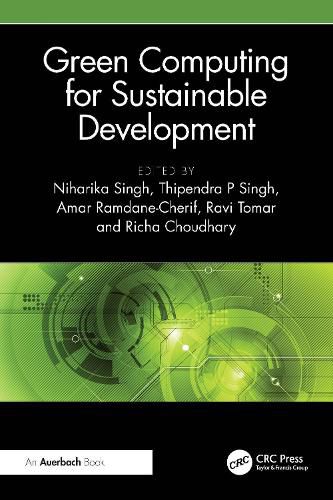Readings Newsletter
Become a Readings Member to make your shopping experience even easier.
Sign in or sign up for free!
You’re not far away from qualifying for FREE standard shipping within Australia
You’ve qualified for FREE standard shipping within Australia
The cart is loading…






Green computing is a revolutionary technique that addresses environmental sustainability. It uses an eco-friendly approach to the design, manufacture, and use of computing resources. This is achieved by cutting down on electronic waste, using renewable energy sources, and consuming less energy. Recyclable materials with minimal environmental impact, software engineering techniques that are optimised, and energy-efficient hardware are examples of many approaches. Advanced technologies such as low-power processors, smart grids, and virtualized computing environments contribute to energy efficiency and waste reduction. Furthermore, integrating green computing with renewable energy sources amplifies its positive impact on the environment. The adoption of green computing practices promotes a circular economy, encourages resource conservation, and supports climate action.
Green Computing for Sustainable Development features chapters that explore issues that concerned with furthering sustainability and green computing. Highlights include:
Neuro-symbolic green computing combining neural networks' learning abilities with symbolic AI's logical reasoning while promoting environmentally friendly practices. Energy-efficient data management, resource provisioning, and the importance of monitoring carbon footprints. The intersection of green computing and wildlife conservation, highlighting how energy-efficient technologies can revolutionize conservation efforts The integration of Geospatial Information Systems (GIS) and Remote Sensing (RS) as innovative solutions for sustainable development. The role of information and communication technology (ICT) in promoting health and well-being The importance of green computing due to growing environmental concerns related to information technology. The integration of AI in sustainable farming practices. The synergy between green computing practices and economic growth in achieving sustainable development. The integration of green computing with e-waste management to tackle environmental challenges in the IT sector. How the "green Internet of Things" (IoT) is transforming smart city development by integrating ecological awareness and sustainability into urban planning.
This book covers the wide range of principles essential for achieving long-term sustainability. It is a step toward fostering a balanced relationship between technological advancement and environmental stewardship.
$9.00 standard shipping within Australia
FREE standard shipping within Australia for orders over $100.00
Express & International shipping calculated at checkout
Green computing is a revolutionary technique that addresses environmental sustainability. It uses an eco-friendly approach to the design, manufacture, and use of computing resources. This is achieved by cutting down on electronic waste, using renewable energy sources, and consuming less energy. Recyclable materials with minimal environmental impact, software engineering techniques that are optimised, and energy-efficient hardware are examples of many approaches. Advanced technologies such as low-power processors, smart grids, and virtualized computing environments contribute to energy efficiency and waste reduction. Furthermore, integrating green computing with renewable energy sources amplifies its positive impact on the environment. The adoption of green computing practices promotes a circular economy, encourages resource conservation, and supports climate action.
Green Computing for Sustainable Development features chapters that explore issues that concerned with furthering sustainability and green computing. Highlights include:
Neuro-symbolic green computing combining neural networks' learning abilities with symbolic AI's logical reasoning while promoting environmentally friendly practices. Energy-efficient data management, resource provisioning, and the importance of monitoring carbon footprints. The intersection of green computing and wildlife conservation, highlighting how energy-efficient technologies can revolutionize conservation efforts The integration of Geospatial Information Systems (GIS) and Remote Sensing (RS) as innovative solutions for sustainable development. The role of information and communication technology (ICT) in promoting health and well-being The importance of green computing due to growing environmental concerns related to information technology. The integration of AI in sustainable farming practices. The synergy between green computing practices and economic growth in achieving sustainable development. The integration of green computing with e-waste management to tackle environmental challenges in the IT sector. How the "green Internet of Things" (IoT) is transforming smart city development by integrating ecological awareness and sustainability into urban planning.
This book covers the wide range of principles essential for achieving long-term sustainability. It is a step toward fostering a balanced relationship between technological advancement and environmental stewardship.